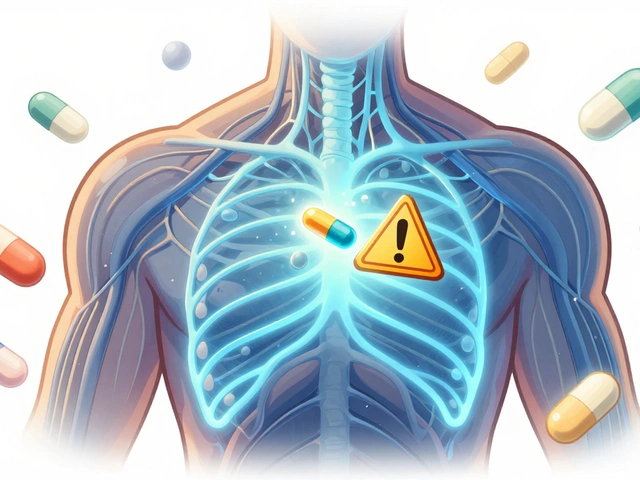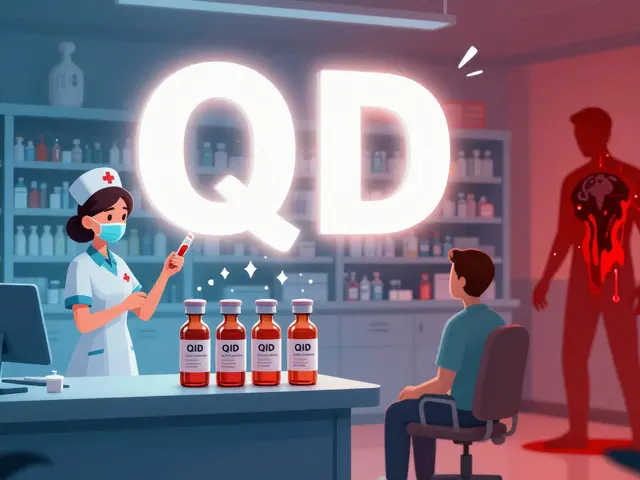
Acid Reducer Comparison Tool
Find out which acid reducer might be best for your situation.
TL;DR
- Pepcid (famotidine) is an H2 blocker that offers fast, short‑term relief for heartburn.
- Proton‑pump inhibitors (PPIs) such as Prilosec and Nexium work slower but last longer, making them better for chronic GERD.
- Older H2 blockers like Tagamet and the withdrawn Zantac have similar action to Pepcid but differ in side‑effect profiles.
- Choose Pepcid for occasional symptoms or when you need a medication that won’t interact with many other drugs.
- Talk to your doctor if you need nightly dosing, have kidney issues, or are on blood thinners.
When the fire in your chest starts flashing, the first thing you want is a quick fix. Pepcid is often the go‑to for that fast‑acting relief, but it isn’t the only player on the market. In this guide we break down how famotidine measures up against its most common rivals, so you can pick the right acid reducer for your lifestyle.
What is Pepcid (Famotidine)?
Famotidine is a prescription and over‑the‑counter medication that belongs to the class of H2 blockers. It works by blocking histamine H2 receptors in the stomach lining, which slows down the production of gastric acid. First approved by the FDA in 1986, Pepcid quickly became a staple for people dealing with heartburn, acid reflux, and even certain types of ulcers.
How Pepcid Works: The H2 Blocker Story
Think of your stomach as a furnace. Histamine is the spark that tells the furnace to turn up the heat. H2 blockers like famotidine act like a fire‑proof blanket, covering the spark and keeping the flame low. The result? Less acid, less irritation, and less pain.
Because it targets a specific receptor, the effect kicks in within 30‑60 minutes and lasts about 8‑12 hours. That’s why doctors often recommend taking it before meals that you know will trigger symptoms.
Key Alternatives to Pepcid
Not every acid problem needs the same fix. Below are the main competitors you’ll hear about when you browse pharmacy aisles or ask a doctor.
Omeprazole (brand name Prilosec) is a proton‑pump inhibitor (PPI) that shuts down the final step of acid production. It takes longer to work-usually a few days to reach full effect-but its relief can last up to 24 hours.
Esomeprazole (brand name Nexium) is another PPI, often marketed as a “stronger” version of omeprazole. Its dosing is similar, but some studies suggest a slightly higher bioavailability.
Cimetidine (brand name Tagamet) is an older H2 blocker. It’s effective, but it has a higher chance of interacting with other drugs because it inhibits certain liver enzymes.
Ranitidine (formerly Zantac) was a widely used H2 blocker until 2020 when NDMA contamination led to its recall. Some generic versions have re‑appeared, but many physicians still advise caution.
Antacids (e.g., Tums, Maalox) are not prescription drugs but provide immediate, short‑term neutralization of stomach acid. They work within minutes but need to be taken frequently.

Side‑by‑Side Comparison
| Drug | Class | Typical Dose | Onset | Duration | Common Side Effects | Best Use Case |
|---|---|---|---|---|---|---|
| Famotidine | H2 blocker | 20‑40mg once or twice daily | 30‑60min | 8‑12h | Headache, dizziness, constipation | Occasional heartburn, ulcer prevention |
| Omeprazole | PPI | 20‑40mg daily | 1‑4days | 24h+ | Diarrhea, nausea, vitaminB12 deficiency (long term) | Chronic GERD, erosive esophagitis |
| Esomeprazole | PPI | 20‑40mg daily | 1‑4days | 24h+ | Headache, abdominal pain | Severe GERD, Barrett’s esophagus |
| Cimetidine | H2 blocker | 300mg twice daily | 30‑60min | 8‑12h | Hormonal changes, drug interactions | Patients needing cheap H2 blocker |
| Ranitidine | H2 blocker | 150mg twice daily | 30‑60min | 8‑12h | Potential NDMA exposure, headache | Legacy users, where approved |
| Antacids (e.g., Tums) | Neutralizing agent | 1‑2 tablets as needed | 5‑10min | 1‑2h | Constipation or diarrhea | Immediate, occasional heartburn |
Decision Criteria: What to Weigh When Choosing
Not all acid reducers are created equal, and the “best” option depends on a handful of factors you probably already think about.
- Speed vs. longevity: Need relief in the next half hour? H2 blockers win. Need a night‑long shield? PPIs take the lead.
- Frequency of use: Sporadic symptoms = Pepcid or antacids. Daily reflux = a PPI.
- Drug interactions: If you’re on blood thinners, warfarin, or certain anti‑epileptics, Pepcid is generally safer than cimetidine.
- Kidney function: Famotidine dose may need adjustment for reduced kidney clearance; PPIs are processed differently.
- Cost and insurance coverage: Generic famotidine and cimetidine are cheap, while brand‑name PPIs can be pricier unless covered.
Pros and Cons of Pepcid Compared to Each Alternative
Versus Omeprazole (Prilosec)
Pepcid acts faster but doesn’t last as long. If you’re battling nightly heartburn, omeprazole’s 24‑hour coverage may reduce the need for multiple doses.
Versus Esomeprazole (Nexium)
Esomeprazole’s higher bioavailability can be a plus for severe GERD, yet it shares the same delayed onset as omeprazole. Pepcid stays the quicker, lower‑cost choice for mild‑to‑moderate symptoms.
Versus Cimetidine (Tagamet)
Cimetidine is more likely to interfere with other meds because it blocks CYP450 enzymes. Pepcid has a cleaner interaction profile, making it a safer bet for patients on multiple prescriptions.
Versus Ranitidine (Zantac)
Both are H2 blockers, but ranitidine’s recall over NDMA contamination removed it from many shelves. Pepcid’s safety record is cleaner, though the two work the same way.
Versus Antacids
Antacids neutralize acid instantly but wear off quickly and can cause rebound acid production. Pepcid provides a more sustained reduction without that rebound effect.
Tips for Safe Use and Maximizing Benefits
- Take famotidine 30‑60 minutes before meals that usually trigger symptoms.
- Don’t crush or chew extended‑release tablets; it can dump the dose all at once.
- If you have chronic kidney disease, ask your doctor about a lower dose or an alternative.
- Combine with lifestyle changes-elevate the head of the bed, avoid large fatty meals, and limit caffeine.
- Monitor for rare side effects like confusion or arrhythmias, especially if you’re over 65.
When to Talk to Your Doctor
If you find yourself reaching for Pepcid more than twice a week, it’s time for a professional evaluation. Persistent symptoms could signal an ulcer, gallbladder issue, or even esophageal cancer-conditions that need diagnostic testing and possibly a different treatment plan.
Also, if you’re on blood thinners, HIV meds, or seizure drugs, double‑check that famotidine won’t interfere. A quick chat with your physician can save you a lot of trial‑and‑error.

Frequently Asked Questions
Can I take Pepcid and a PPI together?
Usually not necessary. Combining an H2 blocker with a PPI can increase the risk of low magnesium levels and may not add extra benefit. Talk to your doctor if you think you need both.
How long is it safe to use Pepcid daily?
Short‑term use (up to 12 weeks) is generally safe. If you need it longer, a doctor may order blood tests to monitor kidney function and vitamin B12 levels.
Is famotidine safe for pregnant women?
Category B in FDA pregnancy labeling, meaning animal studies showed no risk and there are no well‑controlled human studies. Many OB‑GYNs consider it acceptable when needed, but always get clearance first.
What should I do if I miss a dose?
Take it as soon as you remember, unless it’s almost time for the next dose. In that case, skip the missed one-don’t double up.
Can antacids replace Pepcid?
Antacids work instantly but only last a couple of hours. If you need longer protection, especially overnight, Pepcid is a better choice.
Bottom line: Pepcid shines when you need fast, reliable relief without a laundry list of drug interactions. For chronic, night‑time reflux, a PPI may be the smarter long‑term partner. Use the comparison table and decision checklist above to match the drug to your daily reality, then check in with your healthcare provider for a personalized plan.






10 Comments
The article affords a commendable overview, yet it neglects to differentiate adequately between the pharmacokinetic profiles of H₂‑blockers and PPIs; consequently, readers may conflate onset time with duration of effect. Moreover, the omission of dosage‑adjustment guidelines for patients with compromised renal function is a glaring oversight. While the table succinctly summarizes key attributes, the absence of statistical confidence intervals for side‑effect frequencies undermines its scientific rigor. In sum, a more meticulous presentation would bolster credibility.
I get the gist-Pepcid feels like a quick fix for that post‑meal burn, but if you’re dealing with nightly reflux, stepping up to a PPI makes sense. Just remember to give the PPI a few days to settle in.
Famotidine’s rapid onset, typically within thirty to sixty minutes, offers a tangible advantage for acute dyspepsia. However, its pharmacodynamic ceiling-lasting roughly eight to twelve hours-renders it suboptimal for continuous nocturnal acid suppression. Proton‑pump inhibitors, exemplified by omeprazole and esomeprazole, achieve sustained gastric pH elevation for upwards of twenty‑four hours, thereby addressing chronic gastro‑oesophageal reflux disease more effectively. The comparative table correctly lists these duration metrics, yet fails to mention the clinically relevant CYP2C19 polymorphisms prevalent in South Asian populations that affect PPI metabolism. Consequently, a one‑size‑fits‑all prescription paradigm is misguided, especially for Indian patients who may exhibit reduced clearance of certain PPIs. Additionally, the article glosses over the risk of long‑term vitamin B₁₂ depletion associated with chronic PPI use, a concern substantiated by multiple cohort studies. Famotidine, by contrast, carries a negligible impact on nutrient absorption, making it a safer option for prolonged therapy when renal function permits. The piece also omits discussion of the cost disparity; generic famotidine is markedly cheaper than brand‑name PPIs, an economic factor of paramount importance in low‑income regions. Moreover, the withdrawal of ranitidine due to NDMA contamination underscores the necessity of vigilance regarding pharmaceutical safety standards. While the article references this, it does not emphasize that the FDA’s heightened scrutiny has prompted manufacturers to reformulate H₂‑blockers with stricter impurity limits. From a pharmacoeconomic perspective, selecting famotidine first aligns with both efficacy and affordability for the majority of patients experiencing intermittent heartburn. Nonetheless, clinicians must remain alert to the patient’s comorbidities, particularly co‑administration of warfarin or antiretrovirals, where drug‑drug interactions can be clinically significant. The recommendation to adjust famotidine dosage in renal impairment is sound, yet the guidance could be refined by providing explicit dosing algorithms. In practice, initiating therapy with a low‑dose H₂‑blocker and escalating to a PPI only upon failure mirrors evidence‑based step‑therapy protocols. Ultimately, the article succeeds in outlining the basic distinctions but would benefit from deeper integration of genetic, economic, and safety considerations to truly inform prescribers.
For occasional heartburn, Pepcid is the quick‑and‑cheap choice.
One cannot ignore the subtle push by big pharma to downplay H₂‑blockers in favor of profit‑driven PPIs, a maneuver cloaked in “clinical superiority” language while quietly inflating prescription costs.
I understand the frustration of juggling medication schedules, especially when kidney function is a concern; consider discussing a tailored famotidine regimen with your physician, and pair it with lifestyle tweaks like elevating the head of your bed and avoiding late‑night meals.
Oh wow, another 2‑page “guide” that pretends to be groundbreaking-news flash, famotidine has been around since the 80s, so unless you discovered a secret formula hidden in teh appendix, this is just re‑hashing textbook material.
Hey, if you’re leaning toward Pepcid, start with the 20 mg dose before dinner and see how you feel; if the relief isn’t enough, you can always step up to 40 mg, but always check with your doc first-don’t just self‑medicate willy‑nilly.
For those of us who value home‑grown solutions, famotidine offers a reliable, low‑cost option-no need to rely on imported PPIs when the answer is right here 😊.
Nice rundown, but I’d just grab a Tums and call it a day.